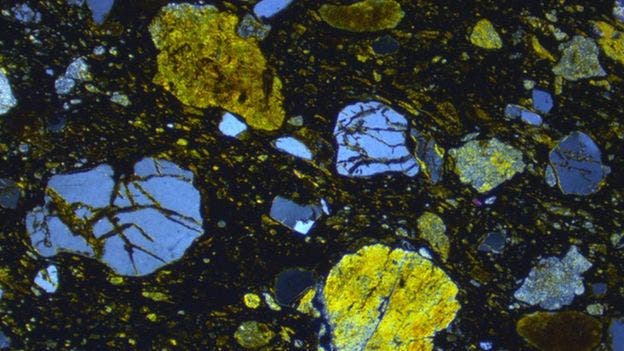Geologists exploring the Isle of Skye have uncovered something out of this world: evidence of a meteorite which bombarded Scotland 60 million years ago.
By now, we have a pretty good idea of our planet’s geological make-up. So when Simon Drake, an associate lecturer in geology at the Birkbeck University of London, came across a meter-thick layer at the base of a 60.0 million-year-old lava flow, he thought it was an ignimbrite — pumice-dominated pyroclastic flow deposits. But when he analyzed it more closely with an electron microscope, he quickly understood that the rock wasn’t what he thought.
The key to this understanding it is a mineral called osbornite. Osbornite is a strange beast, hard to really put in a mineralogical class. It’s also not from Earth — it was only observed in meteorites and comets. The fact that osbornite was found unmelted indicates that it was an original piece of the meteorite. This wasn’t the only smoking gun; geologists also found reidite, an extremely high-pressure form of zircon which is only associated with strong impacts.
“The most compelling evidence really is the presence of vanadium-rich and niobium-rich osbornite. Neither of these have ever been found on Earth before. We have these mineral totally enclosed in native iron, which itself is not of this planet,” Drake says.
They managed to date the layer to sometime between 60 million and 61.4 million years ago and confirmed the initial finding in another place. Dr. Drake said:
“We have found evidence of the impact at two sites and at another potential two sites on the Isle of Skye, at the moment.”
The finding helps put Skye’s rich geological history into context. Even though the isle was studied extensively, the structures were buried beneath a murky swamp which likely dissuaded previous efforts.
“One of the things that is really interesting here is that the volcanological evolution of the Isle of Skye has always been considered to have been started with what’s called a volcanic plume, an enormously large bulk of magma which has come up under what then was the crust that Skye was on,” according to Drake.
“We are now suggesting that this may well have been assisted by a meteorite impact.”
However, there’s still much work to be done. The team still doesn’t know exactly where the meteorite hit, and how it affected local volcanism. It’s unclear if it the meteorite helped trigger volcanism or if the two events are completely unrelated. Hopefully, future studies can help clear out these mysteries and add another piece to the geological puzzle.
Journal Reference: Simon M. Drake et al. Discovery of a meteoritic ejecta layer containing unmelted impactor fragments at the base of Paleocene lavas, Isle of Skye, Scotland. Geology, 2017; DOI: 10.1130/G39452.1










